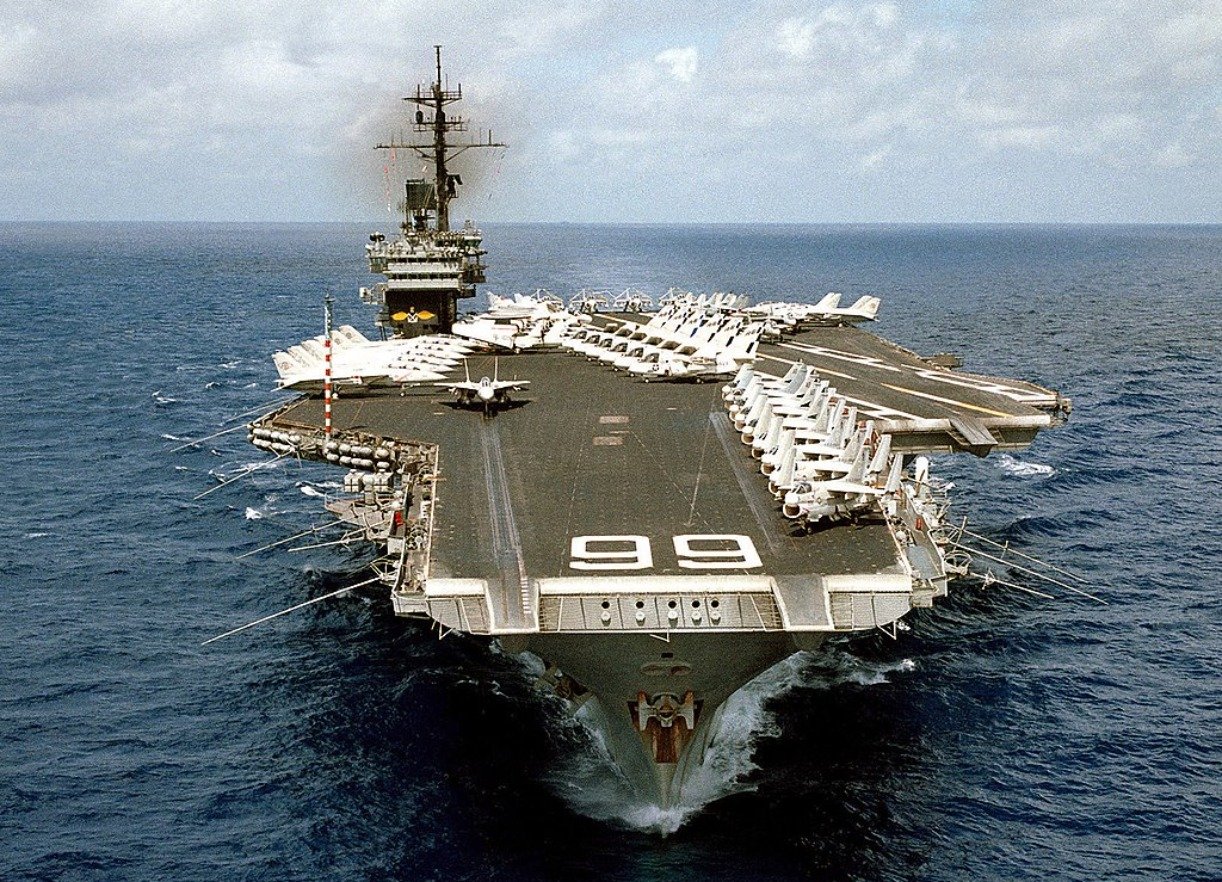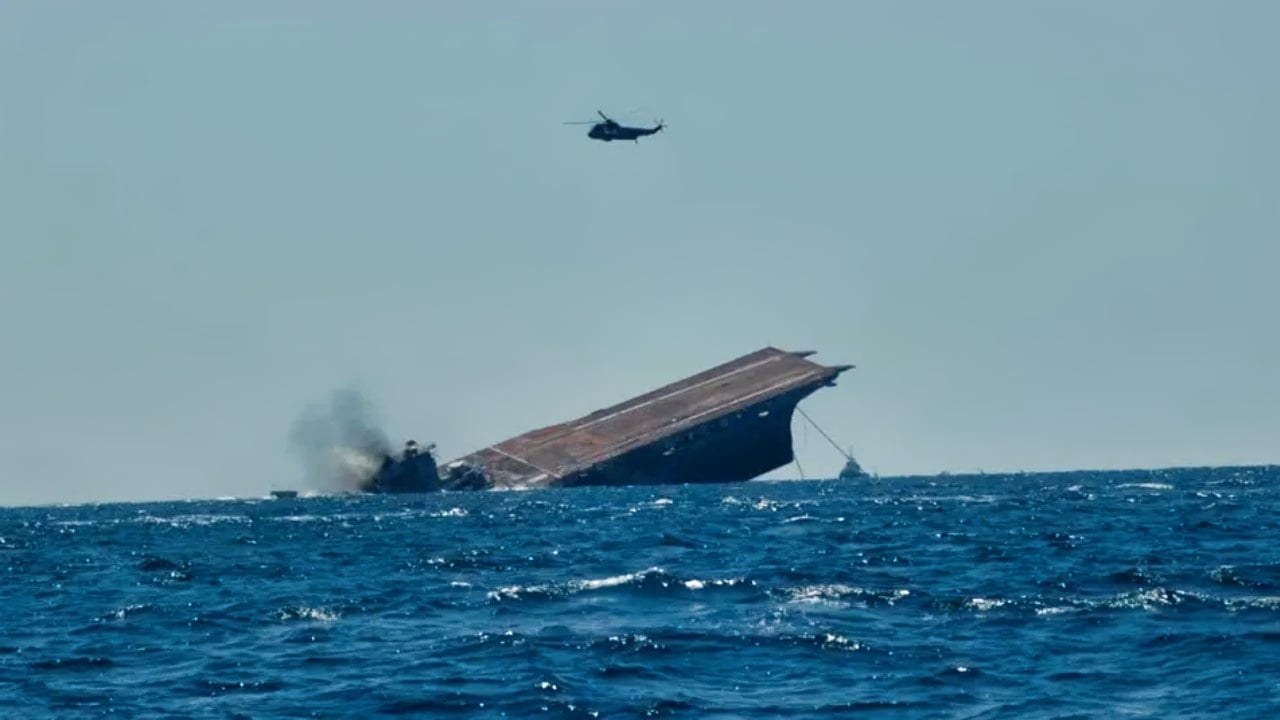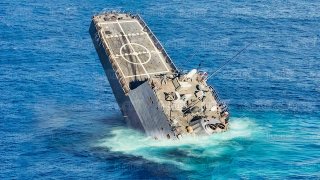'4 Weeks of Explosions': The Navy Failed to Sink Their Own Aircraft Carrier
In 2005, the U.S. Navy sunk the decommissioned USS America in a classified SINKEX exercise to gather data on the resilience of supercarriers. The 30-day scuttling process raised questions about the true survivability of modern carriers like the Nimitz and Gerald R. Ford classes.
What You Need to Know: In 2005, the U.S. Navy sunk the decommissioned USS America in a classified SINKEX exercise to gather data on the resilience of supercarriers. The 30-day scuttling process raised questions about the true survivability of modern carriers like the Nimitz and Gerald R. Ford classes. However, it’s important to note that the goal of the exercise was not to sink the carrier quickly, but to study how such a ship might be destroyed in a slow-motion scenario.

-With the growing anti-access/area denial (A2/AD) threats from nations like China, which can deploy hypersonic weapons and mass-produced anti-ship missiles, the real question is whether these massive vessels can withstand a swift and concentrated attack.
-China’s ability to damage key areas, like the flight deck, could effectively neutralize U.S. carriers without sinking them entirely, posing serious strategic risks in the Indo-Pacific region.
Sinking of USS America Offers Lessons, But Not Guarantees, For Modern Aircraft Carrier Survivability
It took four weeks and multiple methods of attack to finally send the aging Kitty Hawk-class supercarrier, USS America (CV-66) 17,000 feet under the Atlantic Ocean. Back in 2005, the United States Navy wanted to test how an aircraft carrier might be sunk. The carrier that was chosen for this test was the decommissioned non-nuclear supercarrier, USS America, which had a long and storied history (the carrier received an astonishing eight battle stars throughout its time as a ship of the line) serving the US Navy throughout the Cold War.
While some efforts were made in the 1990s to save the aging carrier from the scrapyard, funding woes prevented the warship from being modernized. So, the Navy concocted one last way the great ship could serve US national security needs: being scuttled.
The sinking of the America represents the first time since the Second World War that an aircraft carrier was successful sunk in a combat setting (or, in this case, a simulated combat setting). But scuttling the great warship proved to be a herculean task. Finally, the leviathan was sent to the bottom of the Atlantic. The sinking of the USS America was the first time a carrier of her size had been sent to the bottom of the drink.
The SINKEX Drill
Dubbed “SINKEX” drills by the Navy, much of the lessons learned about sinking the supercarrier remain classified. Multiple images of the sinking warship were taken. But for operational security reasons, the images are classified. All but one, that is. It shows the great ship submerging bow-first into the whirling sea below. The warship’s size, its double-layered hull, and its multiple compartments contributed to the great difficulty in sinking the America.
So many people took to the internet to opine that the nearly 30 days it took to sink one mothballed supercarrier was proof-positive that carriers were the greatest naval weapons platform ever conceived. By implication, anyone who would dare question the efficacy of continuing to blow tens of billions of dollars on these systems would be insane because they so obviously can take a pounding.
To be clear: these boats can take a beating. One would hope they could have a modicum of endurance, given their size, cost, and complexity.
Yet, it should be noted that the Navy was not intending to sink the supercarrier as quickly as possible—as any attacker would be trying to do in a real combat setting. The purpose of the SINKEX drills were to sink the boat in slow-motion so that the eggheads could glean as much data as possible on the various aspects of sinking a modern carrier.

Therefore, the methods of attack on the carrier and the explosives used were not decisive.
Still, it should be acknowledged that even the slow-motion murder attempt of the USS America only succeeded when the Navy finally detonated bombs from within the belly of this great beast.
SINKEX Results and Their Applicability to the Real World for Aircraft Carriers
In combat against any Nimitz-class or even the new Gerald R. Ford-class aircraft carriers, the enemy will most definitely be trying to sink or, at the very least, damage the US carriers as quickly and brutally as possible.
Specifically, China, with its robust anti-access/area denial (A2/AD) defense systems, is planning for a decisive, decapitating strike conducted against any US carrier that enters into areas where the A2/AD systems are present (such as the South China Sea or the Taiwan Strait).
What’s more, China’s mass production capabilities means that they can, as Nikita Khrushchev once boasted of the old Soviet Union, “make rockets like sausages.”
Oh, and don’t forget that China leads the Americans in hypersonic weapons technology and has already made the deployment of hypersonic weapons in combat against American carrier a key tenet of their strategy of denial.
Therefore, all the talk about how the US carriers today are basically unsinkable is a bit ridiculous. And the key thing to understand is that America’s enemies who are deploying A2/AD systems against American flat tops do not need to sink them. All they need to do is damage them—specifically the carrier flight deck—and that would be enough to remove the carrier from the board as it were.
China is Prepared to Sink US Aircraft Carriers
As for the classified findings of the SINKEX drills, as I have written in these pages repeatedly, if they were stored on a server, Chinese hackers have likely already gleaned their secrets. Further, as Bill Gertz reported, Chinese spies stole the detailed manuals on how the Navy trains its sailors to keep warships damaged in battle operational. Chinese forces have had time to integrate this knowledge into anti-ship weapons and tactics.
Resting on the false assurances that it took the US Navy 30 days to sink the America—when their goal at the time was to do a slow sinking of the warship for scientific purposes—is hardly helpful in understanding if China could sink US carriers.
For the US to continue to invest in carriers that have decreasing strategic utility in the age of A2/AD is one of the most irresponsible things we have ever done. The sinking of the USS America is not any indicator of how survivable a modern US carrier would be in the face of Chinese A2/AD fusillades.
Author Experience and Expertise: Brandon J. Weichert
Brandon J. Weichert, a National Interest national security analyst, is a former Congressional staffer and geopolitical analyst who is a contributor at The Washington Times, the Asia Times, and The-Pipeline. He is the author of Winning Space: How America Remains a Superpower, Biohacked: China’s Race to Control Life, and The Shadow War: Iran’s Quest for Supremacy. His next book, A Disaster of Our Own Making: How the West Lost Ukraine, is due October 22 from Encounter Books. Weichert can be followed via Twitter @WeTheBrandon.
All images are Creative Commons or Shutterstock.
From the Vault
Russia Freaked Out: Why the U.S. Navy 'Unretired' the Iowa-Class Battleships
Battleship vs. Battlecruiser: Iowa-Class vs. Russia's Kirov-Class (Who Wins?)


